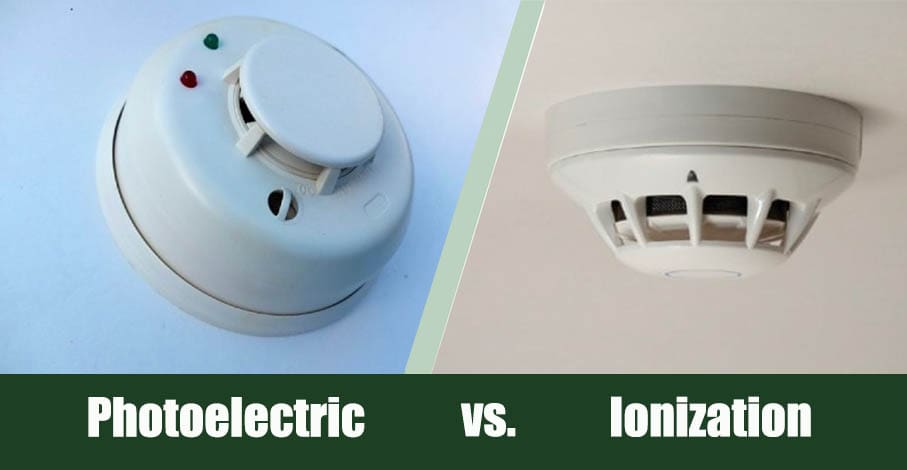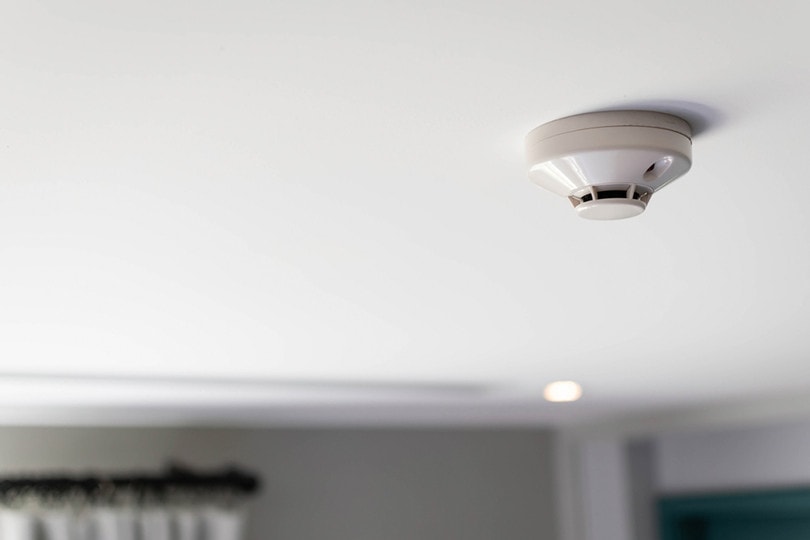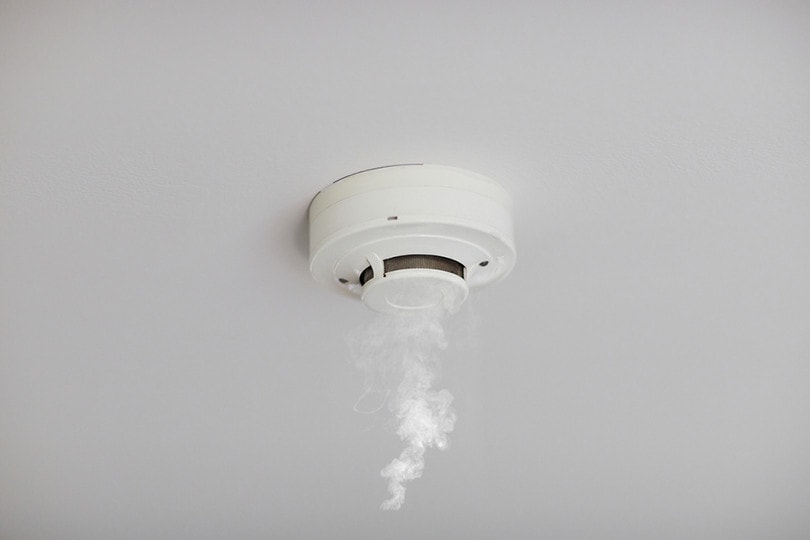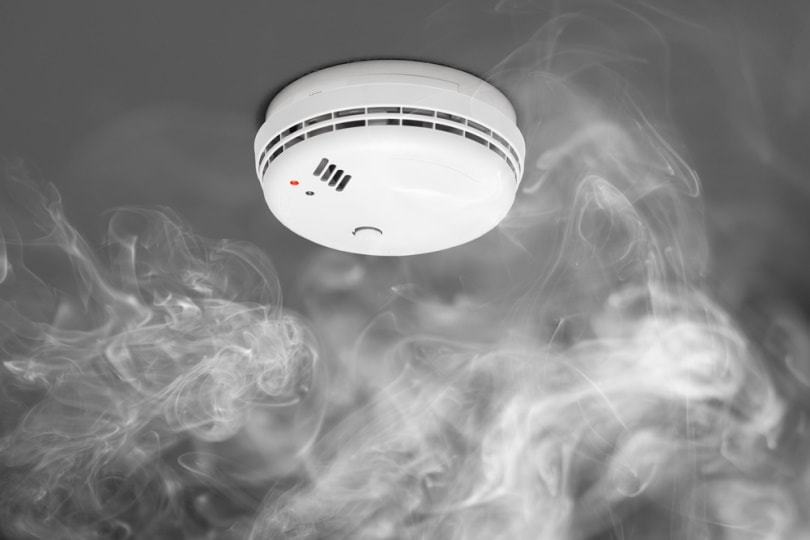Photoelectric vs. Ionization Smoke Detectors: Types, Pros, Cons, & FAQ
-
Pete Ortiz
- Last updated:

Some detectors save lives. They detect the existence of levels of smoke and sound an alarm that gives building residents the chance to act. There are two main types of smoke detectors in use: ionization and photoelectric. Although they both serve the same purpose, they use different technologies.
While the ionization detector tends to respond better to flaming fires, the photoelectric detector performs better at detecting smoldering fires. Because both types of fire can occur, and both are equally dangerous, there is no right answer when it comes to which type of smoke alarm is best. Read on for more details on these two safety technologies and to determine whether one is better for your property than the other.
Overview of Photoelectric Smoke Detectors:
Photoelectric smoke detectors are one of two types of smoke detectors commonly used in homes and other premises to protect people from the potentially devastating effects of fire. They can work in one of two ways, but ultimately have the same components and the same end result.

How They Work
A photoelectric smoke detector contains a small chamber with an LED light inside. The LED light is beamed from one side of the chamber to the other in a straight line. If smoke passes into the chamber, the light is disrupted or diverted. In some cases, disruption prevents the beam from hitting a photosensitive element which, in turn, causes an alarm to sound. In other photoelectric smoke detectors, the disruption causes the beam of light to hit the sensor and triggers the alarm.
Uses and Typical Applications
Photoelectric smoke detectors have been shown to be more effective at detecting smoldering fires. Smoldering fires are those that smolder for long periods of time without producing flames. Although there are minimal or no flames during this period, smoldering fires are known to produce a lot of smoke, and it is this smoke that leads to the majority of fatalities, especially in house fires.
Common causes of smoldering fires include unextinguished cigarettes, red hot embers from the fireplace, and some electrical fires. Such fires can take many minutes, or even hours, before they produce flames, by which time the damage is done.
Because of their efficiency at detecting smoldering fires, photoelectric smoke detectors are most commonly used in rooms with open fires as well as in rooms with upholstered furniture, such as in living rooms and bedrooms.

- Efficient at detecting smoke particles
- Can detect smoldering fires sooner than other smoke detectors
- Photoelectric smoke detectors tend to be more expensive
Overview of Ionization Smoke Detectors:
The other commonly used type of smoke detector is the ionization smoke detector. Although it also works to detect smoke particles, it is not believed to be as effective at detecting larger smoke particles but may be more effective at detecting the smoke from open flame fires.

How They Work
Ionization smoke detectors have two electrodes, between which there is a small amount of radioactive material. When smoke gets into the chamber, this effectively disrupts or stops the flow of ions and reduces the current flow. This causes an alarm to sound. Such smoke detectors can be set off by small bugs, so some manufacturers include a mesh at the opening vent that allows smoke to pass into the chamber but prevents bugs and other bits of debris that can cause a false alarm.
Uses and Typical Applications
Ionization detectors may not work as well for detecting the large smoke particles that are present in smoldering fires, but they can also be more effective at detecting the smoke from open flame fires. However, they can also be prone to false alarms.
As well as false alarms caused by bugs and insects, they can be triggered in areas like the kitchen where open flames are commonplace and expected. As such, the most common locations to place these types of alarms are in hallways and landings—areas where one would not expect open flames and where it is likely to indicate the existence of a potentially dangerous fire.

- Effective at detecting open flame fires
- Less expensive than photoelectric detectors
- Prone to false alarms if placed incorrectly
- Not as effective at detecting smoldering fires
Which Is Best for Your Home?
Ionization and photoelectric smoke detectors are both used to detect smoke and alert people to the potential existence of a fire, but they use different methods to achieve the results. Ionization detectors use a small amount of radioactive material to detect changes in currency, while photoelectric smoke detectors use light beams and photoelectric sensors.
Photoelectric detectors work best at detecting smoldering fires, which are known to give off large quantities of smoke with minimal or no open flames. This type of detector can be placed in most rooms of the house but is most often used in bedrooms and living rooms.
Ionization sensors are better at detecting open flame fires but because they are prone to false alarms when used in rooms like the kitchen or in a room with an open fire, they are typically placed in hallways and landings and not usually used in kitchens. Because different types of fire act and react differently, it is impossible to say which of the two types is better for a house.

Can You Use Both Ionization and Photoelectric Smoke Detectors?
Typically, experts agree that the best approach to protecting a home or other building from fire is through the use of both types of smoke detectors. Both are readily available and while ionization detectors tend to be cheaper, both are reasonably affordable, so you can install photoelectric detectors in living rooms and bedrooms with ionization or dual-sensor detectors in hallways and landings. Dual-sensor detectors combine the features of both types, so you don’t need separate smoke detectors to enjoy protection from most forms of house fires.
Conclusion
Smoke detectors are vital in homes and other buildings because they enable occupants to either extinguish the fire if it is safe to do so or evacuate the building and get to safety. Ionization and photoelectric smoke detectors are the two most common types of smoke detectors. They use different methods of detecting fire or smoke particles, and they have different uses because of these different technologies. Ionization detectors are best for detecting open flame fires while photoelectric sensors are more efficient at detecting smoldering fires. Neither type is better than the other, and the best protection is offered by the use of a combination of these two types of detectors.
- https://www.safelincs.co.uk/smoke-alarm-types-ionisation-alarms-overview/
- https://www.x-sense.com/blogs/tips/what-is-a-photoelectric-smoke-detector
- https://support.firstalert.com/s/article/photo-vs-ion
- https://www.kidde.com/home-safety/en/us/safety-campaigns/ionization-photoelectric/
- https://www.usfa.fema.gov/about/smoke_alarms_position.html
- https://www.nfpa.org/Public-Education/Staying-safe/Safety-equipment/Smoke-alarms/Ionization-vs-photoelectric
- https://blog.koorsen.com/what-is-the-difference-between-ionization-and-photoelectric-smoke-alarms
Featured Image Credit: (Left) Al Serov, Shutterstock | (Right) Andries Oberholzer, Shutterstock
Contents




